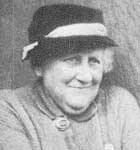
Beatrix Potter was born on 28 July 1866
in South Kensington, London. She lived a
lonely life at home, being educated by
a governess and having little contact with other
people. She had many animals which she
kept as pets, studying them and making drawings.
Her parents took her on three month summer
holidays to Scotland, but when the house
they rented became unavailable, they rented
Wray Castle near Ambleside in the Lake
District. Beatrix was 16 when they first
stayed here. Her parents entertained many
eminent guests, including Hardwicke Rawnsley
vicar of Wray Church, who in 1895 was
to become one of the founders of the National
Trust.
His views on the need to preserve the natural
beauty of Lakeland had a lasting effect on the young Beatrix, who had fallen
in
love with the unspoilt beauty surrounding
the holiday home.
For the next 21 years on and off, the Potters
holidayed in the Lake District, staying once at Wray Castle, once at
Fawe Park, twice at Holehird and nine times
at Lingholm, by Derwentwater, famous now for its rhododendron
gardens. Beatrix loved Derwentwater, and
explored Catbells behind Lingholm. She watched squirrels in the
woods, saw rabbits in the vegetable gardens
of the big house. She made many sketches of the landscape.
They still kept in touch with Rev Rawnsley,
who after 5 years at Wray, moved to Crosthwaite Church just outside
Keswick.
Rawnsley encouraged her drawings, and when
back in London Beatrix made greetings cards of her pictures,
and started a book. Rawnsley encouraged
her to publish, and eventually Frederick Warne published 'The Tale
of Peter Rabbit' in 1902. Her third book,
'Squirrel Nutkin' had background views based on Derwentwater,
Catbells and the Newlands Valley. Fawe
Park featured in 'The Tale of Benjamin Bunny'.
In 1903 Beatrix bought a field in Near Sawrey,
near where they had holidayed that year. She now had an
income from her books, Peter Rabbit having
now sold some 50000 copies. In 1905 she bought Hill Top, a little
farm in Sawrey, and for the next 8 years
she busied herself writing more books, and visiting her farm. In 1909
she bought another farm opposite Hill Top,
Castle Farm, which became her main Lakeland base. Seven of her
books are based in or around Hill Top.
Tom Kitten and Samuel Whiskers lived there. Hill Top is still as it was
then, and is now the most visited literary
shrine in the Lake District.
Beatrix Potter married William Heelis, a
solicitor in Hawkshead, in 1913. Then started the next stage in her life,
being a Lakeland farmer, which lasted for
30 years. The office of William Heelis is now the National Trust's
'Beatrix Potter Gallery'.
In 1923 she bought Troutbeck Park Farm,
and became an expert in breeding Herdwick sheep, winning many
prizes at country shows with them. Beatrix
continued to buy property, and in 1930 bought the Monk Coniston
Estate - 4000 acres from Little Langdale
to Coniston - which contained Tarn Hows, now Lakeland's most
popular piece of landscape.
In 1934 she gave many of her watercolours
and drawings of fungi, mosses and fossils to the Armitt Library in
Ambleside.
When she died on 22 December 1943, Beatrix
Potter left fourteen farms and 4000 acres of land to the National
Trust, together with her flocks of Herdwick
sheep. The Trust now owns 91 hill farms, many of which have a
mainly Herdwick landlord's flock with a
total holding of about 25000 sheep. This was her gift to the nation, her
own beloved countryside for all to enjoy.
Beatrix was the first woman to be elected president-designate of the
Herdwick Sheepbreeders' Association, which
continues to flourish.
Many books have been written about Beatrix
Potter, but the following are some that will be of interest to those
interested in the Lake District:
Hunter Davies has written the book 'Beatrix Potter's Lakeland', with photographs
by
Cressida Pemberton-Piggott. It takes a look at the relationship between
the beautiful
Lakeland countryside, and the very private woman who was inspired by it,
painted it,
farmed it and helped preserve it for future generations to enjoy.
'Beatrix Potter's Derwentwater' by Wynne
Bartlett and Joyce Whalley describes the area around
Derwentwater where Beatrix stayed for her
holidays, and which inspired her to base several of her books in this
area. It also describes walks to be taken
to see these places.
'Beatrix Potter - Her Life in the Lake District'
by W R Mitchell tells about Beatrix's life as a landowner,
conservationist and sheep farmer. The text
is based on interviews with people who knew her - interviews
spread over a period of 40 years during
which time the author was editor of the magazine 'Cumbria'.
The National Trust have published a little
book by Elizabeth Battrick - 'The Real World of Beatrix Potter', which
also uses interviews with people who knew
her. It outlines the support given by Beatrix Potter to the National
Trust and the influence she had on the
Trust's present farming policy.
You can find out more about Beatrix Potters
life
as a farmer in the National Trust booklet 'Beatrix Potter and her
Farms' by Susan Denyer.
'The Tale of Beatrix Potter' by Margaret
Lane is a full biography of Beatrix's life from her childhood in London
to her years in the Lake District.
Beatrix Potter's great-nephew John Heelis
has written 'The Tale of Mrs William Heelis Beatrix Potter' which
covers the relationship with her husband
of thirty years, William Heelis. With anecdotes and reminiscences from
family and friends, this enhances the picture
of Beatrix Potter's life
A book by Susan Denyer - 'Beatrix Potter - at home in the Lake District' has just been published - see National Trust Publications for more details.
URL: http://www.btinternet.com/~lake.district/bpotter.htm
© Instinct Training Ltd,
Cockermouth, Cumbria, UK
Comments- send an email:
webmaster@instinct-training.co.uk.
5 Sep 2000.
Academic Year 2000/2001
© a.r.e.a./Dr.Vicente
Forés López
©jenna little
Universitat de València
Press
jenlit@alumni.uv.es
14171 Hipertextos y Literatura
Inglesa
John Ruskin